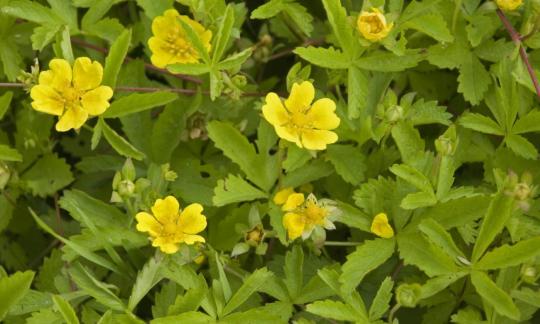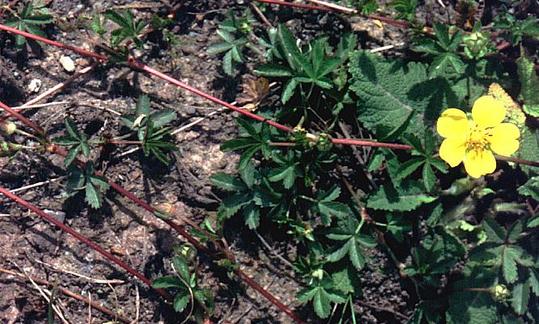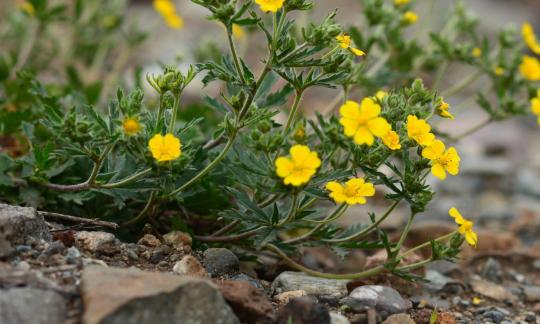Table of contents
Creeping cinquefoil ( Potentilla reptans) tastes good both raw and cooked. With its five-lobed leaves and long runners, cinquefoil is reminiscent of its relative, the strawberry. Organic quality is part of the range.
Creeping cinquefoil: Use in the kitchen
Is creeping cinquefoil edible? Creeping cinquefoil can be used in the kitchen in a similar way to goose cinquefoil ( Potentilla anserina). Since the raw root of the five-cinquefoil ( Potentilla reptans) is more bitter, it was traditionally boiled several times before use. Cooked, the roots of the five-cinquefoil are very edible. They taste good in vegetarian or vegan vegetable stews and soups, prepared as oven-baked vegetables or pickled. The basic taste of the edible leaves of the creeping cinquefoil is slightly sour to bitter-aromatic. They are difficult to chew raw.
How can you eat creeping cinquefoil? The raw leaves are used finely chopped, e.g. in salad dressings and herb mixtures or as freshly pressed vegan raw juice, as an ingredient in green juices and raw food smoothies. Steamed, the wild plant tastes great as a herb puree. The bright yellow flowers of creeping cinquefoil have a sour-sweet taste and make an attractive decoration for various recipes.
Vegan recipe for a smoothie with creeping cinquefoil:
Ingredients (for 2 people): 10 g raw leaves of creeping cinquefoil (organic); 5 g nettle, fresh; 5 g ribwort plantain leaves, raw; 5 g mallow leaves and flowers, raw; 25 g organic lamb's lettuce, fresh; 75 gorganic blueberries, raw; 1 organic banana, peeled; 1 organic orange, peeled; drinking water as needed and 4 raw flowers of cinquefoil as decoration.
Preparation: Put all the carefully washed and peeled ingredients together with a little drinking water in a tall container. Puree the raw greens, the cinquefoil and the fruit with a powerful hand blender to make a creamy smoothie. Add more drinking water as needed until you get the desired consistency. Now serve the vegan raw food drink in two large glasses and decorate with the cinquefoil flowers.
Recipe for (fresh) cinquefoil tea:
Add 2-3 g (1 tsp = approx. 4 g) of finely chopped and coarsely powdered cinquefoil (organic) to cold water. Boil the tea mixture briefly and strain it through a tea strainer after about 5 minutes of steeping. A cold water extract is also recommended, while longer boiling leads to hydrolysis of the ellagitannins and reduced tannin effect. 1
Vegan recipes with creeping cinquefoil can be found under the note: " Recipes that have the most of this ingredient ".
| Not only vegans or vegetarians should read this: Vegans often eat unhealthily. Avoidable nutritional errors. |
Purchasing - where to buy creeping cinquefoil?
Creeping cinquefoil can be purchased as seeds, potted plants or dried as tea (cinquefoil tea), some of which are of controlled organic quality or raw quality (raw food quality). The products mentioned are available from specialist retailers, garden centers or can be ordered online. You rarely find cinquefoil in health food stores, drugstores or organic shops.
In supermarkets such as Coop, Migros, Denner, Volg, Spar, Aldi, Lidl, Rewe, Edeka or Hofer as well as the organic supermarkets Denn's Biomarkt or Alnatura, we have not yet found any raw or dried products containing creeping cinquefoil (cinquefoil).
Found in the wild:
Creeping cinquefoil is a dominant species that shapes the appearance of the habitat. 2 Its main distribution areas are loose sandy and field grasslands. 3 As a nitrogen-loving plant, five-cinquefoil thrives on moist meadows, moist ruderal grasslands, ruderal scree (eg railway ballast), on road embankments, on banks and in fields.
The stems of the herbaceous plant, which are often red, are arched and creeping along the ground, with roots at the nodes. The runners of the cinquefoil can reach a length of 30 to 100 cm and the taproot can reach a depth of up to 45 cm. 4
The leaves of the creeping cinquefoil are shaped like a hand, usually with five fingers (lobes) and are often slightly rolled over at the end. The underside of the leaf is covered in white, felty hairs; the stipules are long and pointed. The stalked flowers are up to 3 cm long and arranged in panicles at the tips of the shoots. The flower consists of five bright yellow petals as well as five sepals, five silicates and many stamens. 3 Each flower of the cinquefoil contains 200 to 240 nuts, which are spread by ants. 4
Season: Young leaves of the cinquefoil can be harvested in April and May, the flowers from May to August and the tuberous roots from September to spring. When does creeping cinquefoil bloom? The main flowering period is from June to August. 3
Storage:
Raw cinquefoil plant leaves can be moistened and placed in a plastic bag and stored in the refrigerator for a few days. Fresh stems will keep for a short time in a vase of water. To dry, spread the plant parts loosely and leave them to dry in an airy place without direct sunlight or in a dehydrator. Sufficiently dried herb can be rubbed easily with your hands. The cinquefoil can then be stored airtight in metal cans or brown jars. Raw leaves can be cut into fine strips, steamed and frozen.
Ingredients - nutritional values - calories:
So far, more than 210 new and known compounds have been confirmed for numerous Potentilla species, including flavonoids, tannins, triterpenes and phenolic compounds. 5 Cinquefoil contains approx. 5-10% tannins, bitter substances, phytosterols, mucilage, coumarins and choline. 3
Raw ribwort plantain (6.5%) or raw ground ivy (approx. 10%) are also rich in tannins. 6.7
The distribution of the main nutrients (proteins, carbohydrates, fats) as well as the calorie content (kcal) of cinquefoil are unknown to us.
The complete ingredients of creeping cinquefoil, the coverage of the daily requirement and comparison values with other ingredients can be found in our nutrient tables in CLICK FOR below the ingredients picture.
Cinquefoil: Effects - Health Aspects
Does creeping cinquefoil have a medicinal effect? Pharmacological studies (mostly in vitro) show that the ingredients contained in Potentilla species are responsible for a wide range of pharmacological activities. These have been shown to be effective against malignant tumors (antineoplastic), blood sugar-lowering (antihyperglycemic), anti-inflammatory, antioxidant, liver-protective (hepatoprotective), nerve cell and nerve fiber protection (neuroprotective) and antibacterial. 5 Most of the pharmacological effects of cinquefoil can be explained by the high proportion of tannins and, to a lesser extent, by triterpenes. 8
The medicinal effects of cinquefoil mentioned are based on the results of a scientific review that provides an update on the state of research on cinquefoil ( Potentilla) for the period between 2009 and 2020. 5
Dangers - Intolerances - Side effects:
Is creeping cinquefoil poisonous? No, but people with irritable stomach should be careful when taking cinquefoil (especially Potentilla anserina) internally, as the symptoms may worsen. 3
Use of cinquefoil as a medicinal plant:
Does cinquefoil have a medicinal effect? Due to the high tannin content, cinquefoil (confirmed for Potentilla anserina) has an astringent effect. This is why extracts are suitable for gargling in cases of bleeding and inflammation of the oral mucosa and gums. 3
Potentilla anserina (goose cinquefoil) and Potentilla reptans (creeping cinquefoil) have not yet been examined by the HMPC ( Committee on Herbal Medicinal Products) or the ESCOP ( Association of National European Societies for Phytotherapy). According to Commission E ( Expert Committee on Herbal Medicinal Products), the internal use of Potentilla anserina (and the cinquefoil medicinal plant) for the supportive treatment of non-specific diarrhea, abdominal and pelvic complaints and painful menstruation, particularly when the above-mentioned ailments are accompanied by cramps, is scientifically indicated. 1,3
To confirm the validity and safety of traditional uses of cinquefoil, future research should focus more on in vivo and clinical studies. 5
Folk medicine - natural medicine:
Is creeping cinquefoil a medicinal plant? Potentilla species are traditional medicinal plants that are mainly used in folk medicine. In folk medicine, for example, the roots ( Potentilla anserina) are chewed for gingivitis. 3 For centuries, P. anserina has been used for menstrual pain (dysmenorrhea), for mouth and throat infections, and as an appetite stimulant and digestive aid. 9
Occurrence - Origin:
Creeping cinquefoil is widespread in the European-Asian region. 3 It occurs up to subalpine altitudes. 2
Growing in the garden or as a pot plant:
Creeping cinquefoil is hardy and can withstand extremely cold temperatures of up to -29 °C. You can grow or plant cinquefoil in places where other plants are less hardy. 10 Creeping cinquefoil can be planted as a ground cover or lawn substitute.
The herb, also known as creeping goosefoot or creeping gander, grows in a carpet-like manner and forms numerous runners. Because of its strong spread and robustness, it displaces other plants and is considered a weed. 10 How can you control creeping cinquefoil (Potentilla reptans)? Options for controlling creeping cinquefoil include pulling it out of moist soil, digging up root remains, mowing it, removing the herb before it flowers and planting other plants.
Another sensible alternative is to keep the creeping goosefoot as a potted plant. The containers must be large enough to provide enough space for the taproots, which can be up to 45 cm long. 10,11
Animal protection - species protection - animal welfare:
The creeping gander is rich in nectar and pollen. The bright yellow flowers are valued by insects such as honey bees, wild bees (miner bees, furrow bees), bumblebees, flies, butterflies and beetles. The critically endangered red cinquefoil sand bee ( Andrena potentillae) exists exclusively on Potentilla species.
Possibility of confusion with Potentilla reptans :
We are not aware of any danger of confusion due to poisonous lookalikes.
There is potential for confusion with the edible medicinal plant creeping avens ( Geum reptans) or with other Potentilla species (see below). In the former case, the most important distinguishing feature is the pleasant aroma (reminiscent of cloves). There is also a similarity with the mock strawberry ( Potentilla indica ; valid name Duchesnea indica (Andrews) Focke). 12 Other common names in German-speaking countries are Indian strawberry, false strawberry or mock strawberry cinquefoil. The tripartite leaves are reminiscent of those of the strawberry plant ( Fragaria), the flowers consist of five yellow petals and sit individually on long stalks. The round, strawberry-like 3 berries stand upright and taste bland. Originally from Southeast Asia, the Indian strawberry is found as a neophyte growing wild on hedges, walls and roadsides in Switzerland, 12 in Central Europe and in North America.
The bushy golden cinquefoil ( Potentilla aurea), also known as yellow cinquefoil or cinquefoil, should not be confused with the creeping cinquefoil, which also has yellow flowers. Other similar species from the genus Potentilla : white cinquefoil ( Potentilla alba), silvery white cinquefoil ( Potentilla argentea), bloodroot ( Potentilla erecta), strawberry cinquefoil ( Potentilla sterilis (L.) Garcke; syn.: Potentilla fragariastrum Pers.), spring cinquefoil ( Potentilla neumanniana Rchb.; syn.: Potentilla tabernaemontani Aschers., Potentilla verna auct.) and others that are scattered or rare or are considered endangered. 3
In terms of its growth form (leaf shape, flower shape, runners), creeping cinquefoil resembles the (wild) strawberry. Clear distinguishing features are the five-lobed leaves and yellow flowers of the cinquefoil, in contrast to the three-lobed leaves and white flowers of the strawberry plant. Both plant species belong to the subfamily Rosoideae.
General information:
Creeping cinquefoil ( Potentilla reptans L.) is a plant species from the species-rich genus Potentilla within the rose family (Rosaceae).
Alternative names:
Since the Middle Ages, creeping cinquefoil has been called five-cinquefoil due to the shape of its leaves. Creeping gander and creeping goosefoot are other alternative names for the wild plant.
Incorrect spellings are creeping cinquefoil, five finger herb, 5 cinquefoil, creeping cinquefoil, Potentila Reptans and Potentilla Reptens.
The English names are Creeping Cinquefoil, European Cinquefoil or Creeping Tormentil and in Spanish the plant is called Cincoenrama.
Literature - Sources:
Bibliography - 10 Sources (Link to the evidence)
| 1. | Blaschek W. (Herausgeber). Wichtl –Teedrogen und Phytopharmaka. Ein Handbuch für die Praxis. Stuttgart: Wissenschaftliche Verlagsgesellschaft mbH; 6. Auflage. 2016. |
| 2. | Infoflora.ch Potentilla reptans L. |
| 3. | Fleischhauer SG, Guthmann J, Spiegelberger R. Enzyklopädie essbare Wildpflanzen. 1. Auflage. Aarau: AT Verlag; 2013. |
| 4. | Oberdorfer E, Schwabe A, Müller T. Pflanzensoziologische Exkursionsflora für Deutschland und angrenzende Gebiete. 8. Auflage. Stuttgart (Hohenheim): Eugen Ulmer Verlag; 2001. |
| 5. | Augustynowicz D, Latté KP, Tomczyk M. Recent phytochemical and pharmacological advances in the genus Potentilla L. sensu lato. An update covering the period from 2009 to 2020. Journal of Ethnopharmacology. 2021;266: 113412. |
| 8. | Tomczyk M, Latté KP. Potentilla. A review of its phytochemical and pharmacological profile. Journal of Ethnopharmacology. 2009;122(2): 184-204. |
| 9. | Benedum J, Loew D, Schilcher H. Arzneipflanzen in der traditionellen Medizin. 4. Auflage. Bonn: Kooperation Phytopharmaka; 2006. |
| 10. | Gartenjournal.net Kriechendes Fingerkraut: Bekämpfen oder dulden und nutzen? |
| 11. | Gartenlexikon.de Kriechendes Fingerkraut bekämpfen: 5 Mittel gegen Potentilla reptans. |
| 12. | Infoflora.ch Duchesnea indica (Andrews) Focke. Scheinerdbeere. |










Comments